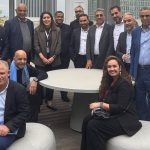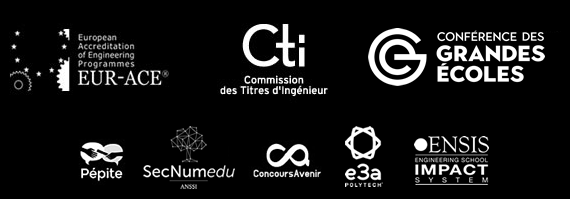Trung Hieu HOANG, enseignant-chercheur, a représenté l’ESILV au congrès ICMM3 qui a eu lieu à Varsovie en Pologne du 08 au 11 septembre dernier avec la présentation de ses travaux de recherche intitulée : “Determination of the size of an RVE for nonlinear random composites”, en collaboration avec Mohamed Guerich et Julien Yvonnet.
Taille effective du volume élémentaire représentatif du comportement élasto-plastique
Lors de cette présentation, Trung Hieu a démontré l’existence d’une taille effective du volume élémentaire représentatif (VRE) du comportement élasto-plastique. Ce travail fait partie des travaux de la thèse de Trung Hieu, encadré par Mohamed Guerich et Julien Yvonnet du laboratoire MSME de l’Université Paris-Est Marne la Vallée. Il entre dans la cadre du projet de recherche ILMAB (Infrastructure Logicielle pour la Modélisation et l’Analyse des Bâtiments), projet du FUI (fonds unique interministériel) dans lequel l’ESILV collabore avec plusieurs partenaires académiques et industriels : CS, NECS, EDF, ESI, OCC, Distene, Oxalya, CSTB, Scilab, CEA, LMT Cachan, Oxand, setec TPI.
Le projet ILMAB
ILMAB « Infrastructure Logicielle pour la Modélisation et l’Analyse des Bâtiments » est un projet de R&D collaboratif d’une durée de 3 ans démarré en septembre 2011. Cofinancé par le Ministère des Finances et soutenu par les pôles Systematic et Advancity, il se concentre sur les usages présents et futurs de la Simulation Numérique dans les métiers de la construction.
ILMAB a pour objectif de faire émerger un ensemble d’outils de conception et d’évaluation pour les bâtiments du futur et d’optimiser les pratiques professionnelles hétérogènes du domaine. Le prototype de chaîne de simulation se présentera sous la forme d’une suite cohérente d’outils spécialisés entrant dans la conception globale de l’objet « Bâtiment », et fera l’objet d’une étude de viabilité technique et économique.
La conférence ICMM
ICMM est une conférence dédiée à la modélisation numérique des matériaux. Elle fait partie des plus grandes conférences thématiques internationales sur la modélisation et la caractérisation des matériaux. La conférence a réuni un grand nombre de chercheurs issus de laboratoires du monde entier : Notheastern University at Boston (USA), Georgia Institute of Techology at Atlanta (USA), University of Manchester (UK), Hamburg University of Technology (Allemagne), St. Peterburg State Polytechnical University (Russia), University of Calgary (Canada), Ecole des Mines Paris (France), Ecole polytechnique Paris (France) Osaka University (Japan), …
Abstract
Determination of the size of an RVE for nonlinear random composites
Trung Hieu Hoang, Mohamed Guerich, and Julien Yvonnet
The representative volume element (RVE) is important to predict effective physical and mechanical of random heterogeneous materials. Several studies have been devoted to determine the size of the RVE for linear [2, 4] and nonlinear materials [1, 3, 6, 9, 10]. However, the procedures are usually based on convergence analysis associated to the stress-strain curve or on quantities related to stress and strains [7]. Defining a procedure to determine the size of an RVE for general nonlinear elastoplastic behavior with hardening remains a difficult problem.
In this paper, a new methodology to estimate the effective size of RVE for nonlinear composites is proposed. The techniques uses some features of statistical convergence analyses developed in Kanit et al., Pelissou et al. and Gitman et al. [1, 2, 6]. Realizations of 2D RVE microstructures with randomly distributed cylindrical fibers are generated. For each one, the coefficients of an empirical macroscopic law are identified. Then the statistical convergence analysis is carried out on the parameters of the macroscopic model instead of the elastic parameters as in the linear case.
Two nonlinear behaviors were considered: von-Mises elasto-plastic behaviour with hardening [8] and elasto-visco-plastic behaviour with creep model using current yield Norton law [5]. Through the convergence of all identified parameters, an effective size of RVE has been determined. The size of the RVE with respect to the model parameters has been performed.
The results show the existence of an effective size of RVE for these microstructures and the studied nonlinear behavior.
References
[1] I.M. Gitman, H. Askes, and L.J. Sluys. Representative volume: Existence and size determination.Engineering Fracture Mechanics, 74(16):2518 – 2534, 2007.
[2] T. Kanit, S. Forest, I. Galliet, V. Mounoury, and D. Jeulin. Determination of the size of the representative volume element for random composites: statistical and numerical approach. International Journal of Solids and Structures, 40(13-14):3647 – 3679, 2003.
[3] V.P. Nguyen, O. Lloberas-Valls, M. Stroeven, and L.J. Sluys. On the existence of representative volumes for softening quasi-brittle materials, a failure zone averaging scheme. Computer Methods in Applied Mechanics and Engineering, 199(45-48):3028 – 3038, 2010.
[4] M. Ostoja-Starzewski. Material spatial randomness: From statistical to representative volume element. Probabilistic Engineering Mechanics, 21(2):112 – 132, 2006.
[5] N.S. Ottosen and M. Ristinmaa. Mechanics of Constitutive Modeling. Elsevier Science Ltd, 2005.
[6] C. Pelissou, J. Baccou, Y. Monerie, and F. Perales. Determination of the size of the representative volume element for random quasi-brittle composites. International Journal of Solids and Structures, 46(14-15):2842 – 2855, 2009.
[7] A. Salahouelhadj and H. Haddadi. Estimation of the size of the rve for isotropic copper polycrystals by using elastic-plastic finite element homogenisation. Computational Materials Science, 48(3):447 – 455, 2010.
[8] J.C. Simo and T.J.R. Hughes. Computational Inelasticity. Springer Verlag, 1998.
[9] A. Temizer and P. Wriggers. An adaptive method for homogenization in orthotropic nonlinear elasticity.






















